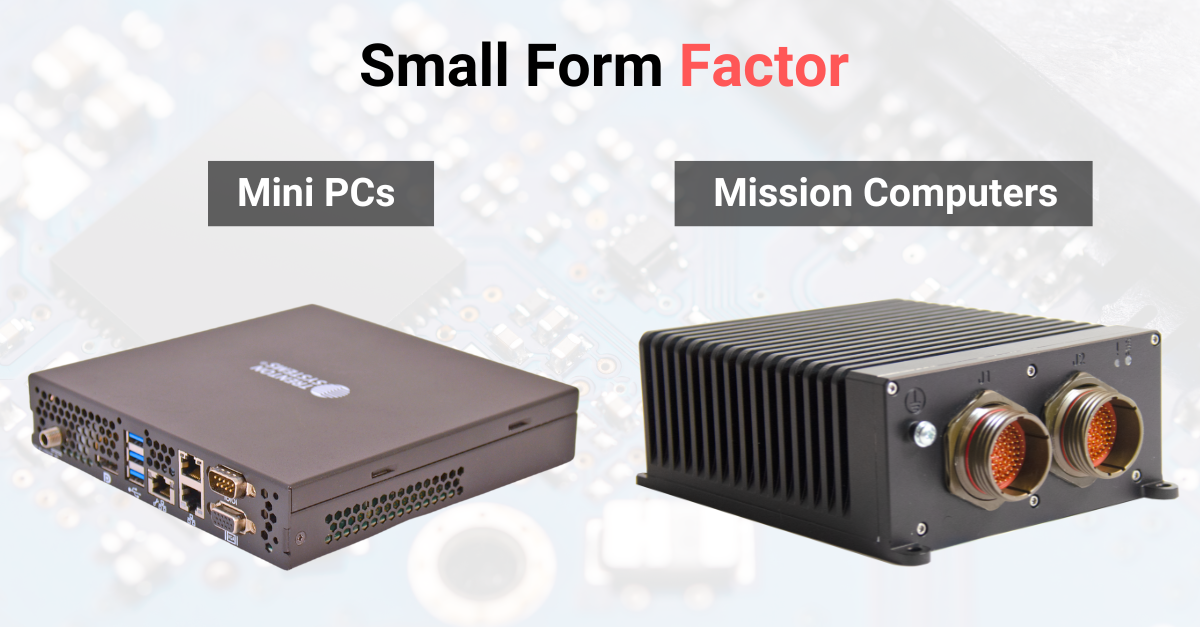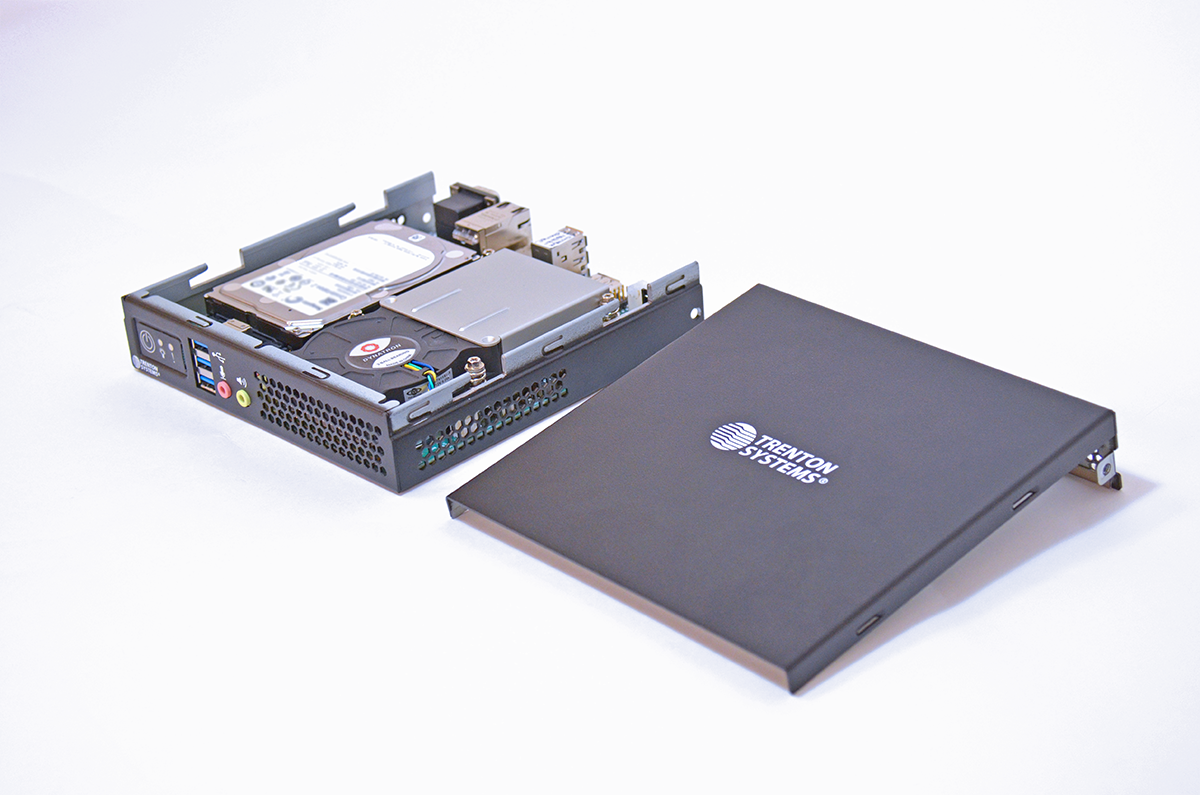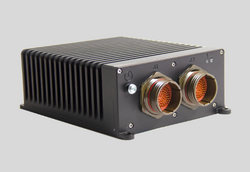Share this
An Exclusive Guide to Small Form Factor Mini PCs and Mission Computers
by Christopher Trick on Oct 10, 2022 2:23:46 PM
 Across the commercial, military, and industrial sectors, customers are looking for lightweight, low-power, and cost-effective alternatives to traditional COTS solutions to meet the demands of an expanding range of applications.
Across the commercial, military, and industrial sectors, customers are looking for lightweight, low-power, and cost-effective alternatives to traditional COTS solutions to meet the demands of an expanding range of applications.
In this blog, you'll learn more about small form factor Mini PCs and mission computers, their major benefits, and how two of Trenton's most advanced solutions come into play.
What is a small form factor computer?
A small form factor computer refers to any computer that is specifically designed to take up as little space as possible.
These devices are designed to be smaller than other similar designs in its field.
Small form factor computers come in all shapes and sizes, with a variety of backplanes, motherboards, and environmental specifications.
Why did the need for small form factor computers arise?
Traditional commercial-off-the-shelf (COTS) solutions are oftentimes too large or costly for new, complex applications.
Small form factor computers emerged in response to these concerns, and many of these systems have proven to be quite effective due to their low-cost, lightweight architecture, low-power requirements, easy upgradability, and ability to operate in harsh environments. (More on this in the next section.)
What are the benefits of small form factor computers?
SWaP-C optimization
SWaP-C optimization means optimized to reduce size, weight, power, and cost.
Due to their small size, small form factor computers take up less space, and they are often lighter than other computing systems, which helps to reduce compute footprint, enhance compute density, and increase portability.
Additionally, small form factor computers use fewer (or no) fans for cooling and low-power hardware, reducing costs, decreasing power consumption and, as a result, avoiding overheating.
Multiple systems can fit into a smaller space, making room for more technology and, as a result, reducing storage costs. With their lightweight architecture, less energy is required to transport these systems, lowering fuel costs.
Modularity and scalability
Small form factor computers are designed with the Modular Open Systems Approach (MOSA) in mind, bringing extensive flexibility and scalability when dealing with legacy or new sensors, networking devices, and onboard systems.
Withstanding harsh environments
Thanks to their ruggedized, hardened enclosure, small form factor computers are able to withstand extreme shock, vibration, temperatures, and humidity, and they can resist the ingress of solids and liquids such as water, dust, dirt, and debris. (More on that later.)
Variations of small form factor computers
Within the commercial, military, and industrial sectors, there are two main types of small form factor computers: mini PCs (personal computers) and mission computers.
What is a mini PC?
A mini PC is small, lightweight, ruggedized personal computer that has undergone extensive testing and certification for usage in extreme conditions and environments.
Mini PCs weigh much less than a full-sized rugged server or workstation, and they take up a lot less space.
For a more comprehensive look at mini PCs, click here.
What is a mission computer?
Mission computers are custom, ruggedized systems that are designed to maximize data processing and meet the most complex SWaP-C requirements.
These computers are often used within the military sector, certified to the most stringent military standards to operate at peak performance within the harshest of environments.
Where does Trenton come into play?
Trenton Systems offers two ruggedized, secure, high-performance computers in small form factor that can be customized per our customers' technical, performance, and environmental specifications: the ION Mini PC and the TAC (Tactical Advanced Computer).
Let's take a look at each:
ION Mini PC
Just 3.2 pounds, the ION Mini PC allows for dedicated data analysis at the edge in a SWaP-optimized solution, allowing military and critical infrastructure personnel to dominate demanding sea, land, air, space, and cyber applications.
The ION can support a single Intel® Core i3, i5, or i7 CPU--the i7 supporting up to 8 cores--to increase processing power; in addition, Intel® Virtualization Technology is embedded into these processors, allowing users to combine multiple workloads onto one system.
The i5 and i7 CPUs are equipped with Intel® Turbo Boost Technology, which increases CPU speeds while staying within temperature and power limits.
The ION also maximizes storage capacity with an internal 2.5" SATA SSD and an M.2 NVMe PCIe card. With up to 32 GB of unfiltered DDR4-2666 RAM across two SODIMM slots, the ION accelerates data retrieval to streamline multiple applications in real-time.
Users can add a 1-piece or 2-piece bracket to the sides of the ION Mini PC, allowing them to mount the system to any surface they desire.
TAC Mission Computers
The TAC (Tactical Advanced Computer) family of small form factor mission computers provides the perfect, all-in-one, SWaP-optimized solution for mission-critical applications across the modern battlespace.
Fanless, sealed, and just under 6 pounds, the TAC is equipped with the latest in embedded computing technology to ensure peak performance within the harshest of environments.
With passive cooling and low-power consumption CPUs, the TAC has low power requirements, avoiding overheating in the field and damage to critical components.
The TAC supports a single Intel® Xeon 1700-D CPU, which has built-in AI, security, I/O, and Ethernet for increased processing and inferencing.
With up to 10 cores per processor, these CPUs allow users to run accelerated workloads simultaneously, control throughput, and enhance data analytics.
Certified to the most complex military and industrial standards such as IP67, MIL-STD-810H, and MIL-STD-901H, the TAC can withstand extreme shock, vibration, temperatures, and humidity while effectively resisting water, dust, dirt, and debris.
The TAC also has two military 38999 connectors, which are a ruggedized, high-performance cylindrical connector family designed to enhance and consolidate cable-to-panel I/O applications; in addition, the TAC can support DDR4-2400 to 2933 RAM as well as front-removable self-encrypting drives (SEDs), keeping large of amounts of data secure, readily available, and easy to access.
There are multiple variations of the TAC in the works, all of which promise to deliver maximum compute power and extreme durability at the edge.
Use Cases
Both the ION Mini PC and the TAC fit seamlessly within the machines of modern warfare including:
- Land vehicles
- Helicopters
- Fixed-wing aircraft
- Unmanned aerial vehicles (UAVs)
- Naval ships
- Submarines
These systems can also be used for a variety of multi-domain applications such as:
- C6ISR
- JADC2
- Signal intelligence (SIGINT)
- Electronic warfare (EW)
- Data acquisition (DAQ)
- Military satellite communications (MILSATCOM)
.....and so much more!
Final thoughts
Small form factor computers, Mini PCs and mission computers alike, help customers within the commercial, military, and industrial sectors enhance a wide variety of applications that require SWaP-optimized systems with edge compute capabilities.
Extra ruggedized with next-gen Intel® processors, small form factor computers like the ION Mini PC and the TAC are the perfect solutions to help customers bolster performance, increase situational awareness, and strengthen real-time decision-making capabilities in the harshest of environments, in the most constrained spaces.
Trenton's line of custom, USA-made, high-performance computing systems are zero-trust architected, equipped with multi-layer cybersecurity technologies across the hardware, firmware, software, and network stack, to protect data-at-rest, data-in-transit, and data-in-use from unauthorized access.
With a tight grip on our supply chain, we help our customers navigate today's supply chain constraints with risk management methodologies such as BIOS control and customization, a counterfeit parts protection (CPP) program, and the ability to "engineer-in" alternative parts and components.
In addition, we offer a five-year warranty program, strict revision control, end-of-life (EOL) notices, and in-house support to maintain a system's functionality, and, when contractually required, make customers aware when a transition to a new product may be necessary.
Want to learn more about how we can help you configure a small form factor computer for your edge compute needs? Just reach out to us anytime here.
Team Trenton is at your service. 😎👍💯🇺🇸
Share this
- High-performance computers (42)
- Military computers (38)
- Rugged computers (32)
- Cybersecurity (25)
- Industrial computers (25)
- Military servers (24)
- MIL-SPEC (20)
- Rugged servers (19)
- Press Release (17)
- Industrial servers (16)
- MIL-STD-810 (16)
- 5G Technology (14)
- Intel (13)
- Rack mount servers (12)
- processing (12)
- Computer hardware (11)
- Edge computing (11)
- Rugged workstations (11)
- Made in USA (10)
- Partnerships (9)
- Rugged computing (9)
- Sales, Marketing, and Business Development (9)
- Trenton Systems (9)
- networking (9)
- Peripheral Component Interconnect Express (PCIe) (7)
- Encryption (6)
- Federal Information Processing Standards (FIPS) (6)
- GPUs (6)
- IPU (6)
- Joint All-Domain Command and Control (JADC2) (6)
- Server motherboards (6)
- artificial intelligence (6)
- Computer stress tests (5)
- Cross domain solutions (5)
- Mission-critical servers (5)
- Rugged mini PCs (5)
- AI (4)
- BIOS (4)
- CPU (4)
- Defense (4)
- Military primes (4)
- Mission-critical systems (4)
- Platform Firmware Resilience (PFR) (4)
- Rugged blade servers (4)
- containerization (4)
- data protection (4)
- virtualization (4)
- Counterfeit electronic parts (3)
- DO-160 (3)
- Edge servers (3)
- Firmware (3)
- HPC (3)
- Just a Bunch of Disks (JBOD) (3)
- Leadership (3)
- Navy (3)
- O-RAN (3)
- RAID (3)
- RAM (3)
- Revision control (3)
- Ruggedization (3)
- SATCOM (3)
- Storage servers (3)
- Supply chain (3)
- Tactical Advanced Computer (TAC) (3)
- Wide-temp computers (3)
- computers made in the USA (3)
- data transfer (3)
- deep learning (3)
- embedded computers (3)
- embedded systems (3)
- firmware security (3)
- machine learning (3)
- Automatic test equipment (ATE) (2)
- C6ISR (2)
- COTS (2)
- COVID-19 (2)
- CPUs (2)
- Compliance (2)
- Compute Express Link (CXL) (2)
- Computer networking (2)
- Controlled Unclassified Information (CUI) (2)
- DDR (2)
- DDR4 (2)
- DPU (2)
- Dual CPU motherboards (2)
- EW (2)
- I/O (2)
- Military standards (2)
- NVIDIA (2)
- NVMe SSDs (2)
- PCIe (2)
- PCIe 4.0 (2)
- PCIe 5.0 (2)
- RAN (2)
- SIGINT (2)
- SWaP-C (2)
- Software Guard Extensions (SGX) (2)
- Submarines (2)
- Supply chain security (2)
- TAA compliance (2)
- airborne (2)
- as9100d (2)
- chassis (2)
- data diode (2)
- end-to-end solution (2)
- hardware security (2)
- hardware virtualization (2)
- integrated combat system (2)
- manufacturing reps (2)
- memory (2)
- mission computers (2)
- private 5G (2)
- protection (2)
- secure by design (2)
- small form factor (2)
- software security (2)
- vRAN (2)
- zero trust (2)
- zero trust architecture (2)
- 3U BAM Server (1)
- 4G (1)
- 4U (1)
- 5G Frequencies (1)
- 5G Frequency Bands (1)
- AI/ML/DL (1)
- Access CDS (1)
- Aegis Combat System (1)
- Armed Forces (1)
- Asymmetric encryption (1)
- C-RAN (1)
- COMINT (1)
- Cloud-based CDS (1)
- Coast Guard (1)
- Compliance testing (1)
- Computer life cycle (1)
- Containers (1)
- D-RAN (1)
- DART (1)
- DDR5 (1)
- DMEA (1)
- Data Center Modular Hardware System (DC-MHS) (1)
- Data Plane Development Kit (DPDK) (1)
- Defense Advanced Research Projects (DARP) (1)
- ELINT (1)
- EMI (1)
- EO/IR (1)
- Electromagnetic Interference (1)
- Electronic Warfare (EW) (1)
- FIPS 140-2 (1)
- FIPS 140-3 (1)
- Field Programmable Gate Array (FPGA) (1)
- Ground Control Stations (GCS) (1)
- Hardware-based CDS (1)
- Hybrid CDS (1)
- IES.5G (1)
- ION Mini PC (1)
- IP Ratings (1)
- IPMI (1)
- Industrial Internet of Things (IIoT) (1)
- Industry news (1)
- Integrated Base Defense (IBD) (1)
- LAN ports (1)
- LTE (1)
- Life cycle management (1)
- Lockheed Martin (1)
- MIL-S-901 (1)
- MIL-STD-167-1 (1)
- MIL-STD-461 (1)
- MIL-STD-464 (1)
- MOSA (1)
- Multi-Access Edge Computing (1)
- NASA (1)
- NIC (1)
- NIC Card (1)
- NVMe (1)
- O-RAN compliant (1)
- Oil and Gas (1)
- Open Compute Project (OCP) (1)
- OpenRAN (1)
- P4 (1)
- PCIe card (1)
- PCIe lane (1)
- PCIe slot (1)
- Precision timestamping (1)
- Product life cycle (1)
- ROM (1)
- Raytheon (1)
- Remotely piloted aircraft (RPA) (1)
- Rugged computing glossary (1)
- SEDs (1)
- SIM Card (1)
- Secure boot (1)
- Sensor Open Systems Architecture (SOSA) (1)
- Small form-factor pluggable (SFP) (1)
- Smart Edge (1)
- Smart NIC (1)
- SmartNIC (1)
- Software-based CDS (1)
- Symmetric encryption (1)
- System hardening (1)
- System hardening best practices (1)
- TME (1)
- Tech Partners (1)
- Total Memory Encryption (TME) (1)
- Transfer CDS (1)
- USB ports (1)
- VMEbus International Trade Association (VITA) (1)
- Vertical Lift Consortium (VLC) (1)
- Virtual machines (1)
- What are embedded systems? (1)
- Wired access backhaul (1)
- Wireless access backhaul (1)
- accredidation (1)
- aerospace (1)
- air gaps (1)
- airborne computers (1)
- asteroid (1)
- authentication (1)
- autonomous (1)
- certification (1)
- cognitive software-defined radios (CDRS) (1)
- command and control (C2) (1)
- communications (1)
- cores (1)
- custom (1)
- customer service (1)
- customer support (1)
- data linking (1)
- data recording (1)
- ethernet (1)
- full disk encryption (1)
- hardware monitoring (1)
- heat sink (1)
- hypervisor (1)
- in-house technical support (1)
- input (1)
- integrated edge solution (1)
- international business (1)
- licensed spectrum (1)
- liquid cooling (1)
- mCOTS (1)
- microelectronics (1)
- missile defense (1)
- mixed criticality (1)
- moving (1)
- multi-factor authentication (1)
- network slicing (1)
- neural networks (1)
- new headquarters (1)
- next generation interceptor (1)
- non-volatile memory (1)
- operating system (1)
- output (1)
- outsourced technical support (1)
- post-boot (1)
- pre-boot (1)
- private networks (1)
- public networks (1)
- radio access network (RAN) (1)
- reconnaissance (1)
- rugged memory (1)
- secure flash (1)
- security (1)
- self-encrypting drives (SEDs) (1)
- sff (1)
- software (1)
- software-defined radios (SDRs) (1)
- speeds and feeds (1)
- standalone (1)
- storage (1)
- systems (1)
- tactical wide area networks (1)
- technical support (1)
- technology (1)
- third-party motherboards (1)
- troposcatter communication (1)
- unlicensed spectrum (1)
- volatile memory (1)
- vpx (1)
- zero trust network (1)
- January 2025 (1)
- November 2024 (1)
- October 2024 (1)
- August 2024 (1)
- July 2024 (1)
- May 2024 (1)
- April 2024 (3)
- February 2024 (1)
- November 2023 (1)
- October 2023 (1)
- July 2023 (1)
- June 2023 (3)
- May 2023 (7)
- April 2023 (5)
- March 2023 (7)
- December 2022 (2)
- November 2022 (6)
- October 2022 (7)
- September 2022 (8)
- August 2022 (3)
- July 2022 (4)
- June 2022 (13)
- May 2022 (10)
- April 2022 (4)
- March 2022 (11)
- February 2022 (4)
- January 2022 (4)
- December 2021 (1)
- November 2021 (4)
- September 2021 (2)
- August 2021 (1)
- July 2021 (2)
- June 2021 (3)
- May 2021 (4)
- April 2021 (3)
- March 2021 (3)
- February 2021 (8)
- January 2021 (4)
- December 2020 (5)
- November 2020 (5)
- October 2020 (4)
- September 2020 (4)
- August 2020 (6)
- July 2020 (9)
- June 2020 (11)
- May 2020 (13)
- April 2020 (8)
- February 2020 (1)
- January 2020 (1)
- October 2019 (1)
- August 2019 (2)
- July 2019 (2)
- March 2019 (1)
- January 2019 (2)
- December 2018 (1)
- November 2018 (2)
- October 2018 (5)
- September 2018 (3)
- July 2018 (1)
- April 2018 (2)
- March 2018 (1)
- February 2018 (9)
- January 2018 (27)
- December 2017 (1)
- November 2017 (2)
- October 2017 (3)
/Trenton%20Systems%20Circular%20Logo-3.png?width=50&height=50&name=Trenton%20Systems%20Circular%20Logo-3.png)




No Comments Yet
Let us know what you think